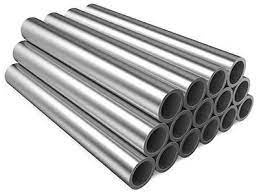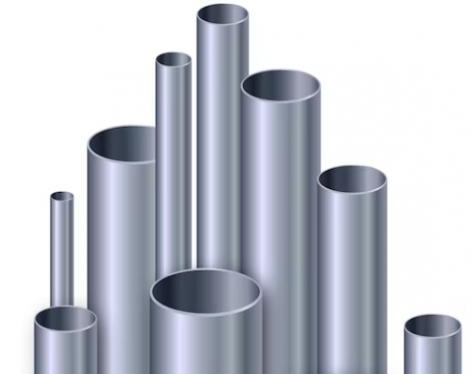What is titanium alloy seamless pipe
Titanium alloy seamless pipe is a long pipe made of titanium alloy material with a hollow section and no seams around it. Initially it was mainly used to make aircraft engine compressor components and structural parts for rockets, missiles and high-speed aircraft. Since the mid-1960s, it has been gradually used in general industrial manufacturing fields such as electrodes in the electrolysis industry, condensers in power stations, heaters for petroleum refining and desalination, and environmental pollution control devices.
Compared with other metal materials, titanium alloy has the following advantages:
①High specific strength (tensile strength/density), the tensile strength can reach 100~140kgf/mm2, but the density is only 60% of steel.
② It has good medium-temperature strength. The operating temperature is several hundred degrees higher than that of aluminum alloy. It can still maintain the required strength at medium temperatures and can work for a long time at temperatures of 450 to 500°C.
③Good corrosion resistance. A uniform and dense oxide film is immediately formed on the titanium surface in the atmosphere, which has the ability to resist erosion by various media. Generally, titanium has good corrosion resistance in oxidizing and neutral media, and its corrosion resistance in seawater, wet chlorine and chloride solutions is even better. However, in reducing media, such as hydrochloric acid and other solutions, titanium has poor corrosion resistance.
④Titanium alloys with good low-temperature properties and extremely low interstitial elements, such as TA7, can maintain a certain plasticity at -253°C.
⑤ Low elastic modulus, small thermal conductivity, and no ferromagnetism.

Characteristics of titanium alloy seamless pipes
①The oxidation resistance of titanium alloy seamless pipes is very good. Titanium alloy has a low oxidation rate and can significantly slow down the oxidation reaction in high temperature environments. The oxide film generated on the surface of titanium alloy can prevent further penetration of oxygen molecules and effectively protect its internal structure from the effects of oxidation. Therefore, titanium alloy seamless pipes can maintain their original performance and stability in high temperature environments.
②Titanium alloy seamless pipe has excellent high temperature resistance. Titanium alloy has a higher melting point, about 1668 degrees Celsius, which is much higher than other common metal materials such as stainless steel and aluminum alloys. In high temperature environments, titanium alloy seamless pipes can maintain high strength and hardness and are not easy to soften or deform. Therefore, titanium alloy seamless pipes can withstand high pressure and high stress under high temperature conditions and have good durability.
③Titanium alloy seamless pipe has good corrosion resistance. Titanium alloys can form a stable oxide film at high temperatures to prevent contact between corrosive media and titanium alloys, thereby reducing the occurrence of corrosion. Titanium alloy seamless pipes can withstand corrosion from various strong acids, strong alkali and salt water, and are widely used in chemical industry, marine engineering, oil and natural gas and other fields.
④Titanium alloy seamless pipes also have high thermal conductivity. Titanium alloy has a high thermal conductivity and can quickly conduct heat at high temperatures to evenly distribute the temperature of the pipe to avoid local overheating or overcooling. This is very important for some equipment and processes that require high temperature accuracy.
Titanium alloy seamless pipe rolling method
The rolling of titanium alloy seamless pipes is generally carried out by reciprocating (i.e. Pilgrim) cold rolling pipe machines. During the processing, two-roller (LG) and multi-roller (LD) rolling mills are generally used for multi-pass rolling. During the deformation process, titanium pipes gradually undergo wall and diameter reduction as the rolling mill rotates and feeds. A pipe with a unit length generally undergoes 5 to 10 rolling and finishing operations in one rolling pass to obtain the desired shape required by the process. Pipe size specifications. The cold-rolled pipe machine can perform large diameter reduction and wall reduction processing, but the dimensional accuracy after rolling is low, and cracks, unevenness, etc. are prone to occur at the end of the pipe. For cracking, the main method is to grind and smooth the pipe blank before processing. The problem can be solved by straightening the pipe ends; for uneven pipe ends, similar to a "fish mouth" phenomenon, flat ends need to be processed during subsequent processing, otherwise problems will occur.
Titanium alloy seamless pipe is a long pipe made of titanium alloy material with a hollow section and no seams around it. Initially it was mainly used to make aircraft engine compressor components and structural parts for rockets, missiles and high-speed aircraft. Since the mid-1960s, it has been gradually used in general industrial manufacturing fields such as electrodes in the electrolysis industry, condensers in power stations, heaters for petroleum refining and desalination, and environmental pollution control devices.
Compared with other metal materials, titanium alloy has the following advantages:
①High specific strength (tensile strength/density), the tensile strength can reach 100~140kgf/mm2, but the density is only 60% of steel.
② It has good medium-temperature strength. The operating temperature is several hundred degrees higher than that of aluminum alloy. It can still maintain the required strength at medium temperatures and can work for a long time at temperatures of 450 to 500°C.
③Good corrosion resistance. A uniform and dense oxide film is immediately formed on the titanium surface in the atmosphere, which has the ability to resist erosion by various media. Generally, titanium has good corrosion resistance in oxidizing and neutral media, and its corrosion resistance in seawater, wet chlorine and chloride solutions is even better. However, in reducing media, such as hydrochloric acid and other solutions, titanium has poor corrosion resistance.
④Titanium alloys with good low-temperature properties and extremely low interstitial elements, such as TA7, can maintain a certain plasticity at -253°C.
⑤ Low elastic modulus, small thermal conductivity, and no ferromagnetism.

Characteristics of titanium alloy seamless pipes
①The oxidation resistance of titanium alloy seamless pipes is very good. Titanium alloy has a low oxidation rate and can significantly slow down the oxidation reaction in high temperature environments. The oxide film generated on the surface of titanium alloy can prevent further penetration of oxygen molecules and effectively protect its internal structure from the effects of oxidation. Therefore, titanium alloy seamless pipes can maintain their original performance and stability in high temperature environments.
②Titanium alloy seamless pipe has excellent high temperature resistance. Titanium alloy has a higher melting point, about 1668 degrees Celsius, which is much higher than other common metal materials such as stainless steel and aluminum alloys. In high temperature environments, titanium alloy seamless pipes can maintain high strength and hardness and are not easy to soften or deform. Therefore, titanium alloy seamless pipes can withstand high pressure and high stress under high temperature conditions and have good durability.
③Titanium alloy seamless pipe has good corrosion resistance. Titanium alloys can form a stable oxide film at high temperatures to prevent contact between corrosive media and titanium alloys, thereby reducing the occurrence of corrosion. Titanium alloy seamless pipes can withstand corrosion from various strong acids, strong alkali and salt water, and are widely used in chemical industry, marine engineering, oil and natural gas and other fields.
④Titanium alloy seamless pipes also have high thermal conductivity. Titanium alloy has a high thermal conductivity and can quickly conduct heat at high temperatures to evenly distribute the temperature of the pipe to avoid local overheating or overcooling. This is very important for some equipment and processes that require high temperature accuracy.
Titanium alloy seamless pipe rolling method
The rolling of titanium alloy seamless pipes is generally carried out by reciprocating (i.e. Pilgrim) cold rolling pipe machines. During the processing, two-roller (LG) and multi-roller (LD) rolling mills are generally used for multi-pass rolling. During the deformation process, titanium pipes gradually undergo wall and diameter reduction as the rolling mill rotates and feeds. A pipe with a unit length generally undergoes 5 to 10 rolling and finishing operations in one rolling pass to obtain the desired shape required by the process. Pipe size specifications. The cold-rolled pipe machine can perform large diameter reduction and wall reduction processing, but the dimensional accuracy after rolling is low, and cracks, unevenness, etc. are prone to occur at the end of the pipe. For cracking, the main method is to grind and smooth the pipe blank before processing. The problem can be solved by straightening the pipe ends; for uneven pipe ends, similar to a "fish mouth" phenomenon, flat ends need to be processed during subsequent processing, otherwise problems will occur.









